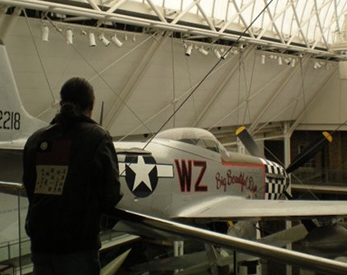
Leather Jacket















Published on 6 June 2024 by Andrew Owen (5 minutes)
Like many boys before me, as I child I wanted to be a fighter pilot. I made Airfix models of Mustangs and Messerschmidts. I went to the Wales Aircraft Museum (closed in 2000) and sat in fighter cockpits. I wore jackets that looked like flight jackets. I had a radio that could receive aircraft transmissions wired up in my bedroom. I even got as far as talking to the Royal Air Force about a career, but gave up when I was told my eyesight meant I’d only be able to make navigator.
“Long hair minimizes the need for barbers; socks can be done without; one leather jacket solves the coat problem for many years; suspenders are superfluous.” —Albert Einstein
In retrospect, I was lucky. I later encountered a Lancaster tail gunner who had shot down exactly one pilot during World War II. Tail gunners probably had the worst survival rate in the service. The position was exposed, it was too cramped to wear a parachute, and for an attacking fighter it was imperative to eliminate the tail gunner before attempting to destroy the bomber. There can be no doubt that if he had not shot down that German pilot, he would be dead. And yet, every night he dreamed the same dream; watching the plane descend, praying for the pilot to safely eject, the ball of flame, and knowing he had taken a life. There are no heroes in war, only survivors.
It is possible to appreciate warbirds, the fastest gasoline engined aircraft ever made, without being a war buff. The North American P-51D, dubbed the “Cadillac of the Skies”, came about as a result of a British order for additional aircraft because it couldn’t build them fast enough itself. A prototype was to be built in 120 days or less, and the designers were furnished with the plans of a recently captured Messerschmidts Bf 109. The order for 320 aircraft was fulfilled at a cost of US$15 million. The ‘P’ in the designation is for its pursuit role, predating the current ‘F’ designation for fighter planes. It used a laminar-flow wing to achieve a much greater fuel efficiency than earlier aircraft, and while heavier than a Spitfire it was also up to 40 mph faster when fitted with the same engine. I hope to go up in one of the remaining two-seater versions one day.
Another boy with dreams of becoming a fighter pilot was the young J.G. Ballard. A fictionalized account of his early years in Shanghai, where he was eventually interred with his parents in a Japanese prisoner of war camp, is told in the novel “Empire of the Sun”. The screenplay for the Spielberg film of the novel was written by Tom Stoppard, but it was actually another writer who was brought in to cover who gave the boy Jim a crew-cut and a leather jacket. After watching the film that was the jacket I wanted.
The jacket in question tells another story altogether, that of the American Volunteer Group, known as the “Flying Tigers”. This group of volunteers from the air wings of the various services (there was no US Air Force yet) were given honorable discharges and flown out to China under the guise of a group of “English teachers”. There, under General Chennault, they were to assist the Chinese in repelling the Japanese. This would have taken place before the US entry into the war, but in practice Pearl Harbor took place before the AVG’s first engagement.
There are some problems figuring out what the jacket used in the film is supposed to be though. First, from the color of the collar it appears to be a MIL-J-7823 (first issued in 1951) at the earliest. AVG pilots kept the jackets issued by their original squadrons so you’d expect it to be an M-422A (issued in 1940) at the latest. Then there’s the China-Burma-India (CBI) patch (visible on the left shoulder). That makes it more likely the jacket in question is supposed to have belonged to a Fourteenth Air Force pilot. But that group didn’t come into existence until 1943 so it’s a little hard to figure out how the jacket might have made its way into a civilian internment camp. It’s not possible to know which it’s supposed to be because the front squadron patch is missing. If it was an M-422A it would have had a patch for one of three AVG squadrons; the Adam & Eves, the Panda Bears or the Hell’s Angels (the original ones). Otherwise, it would have had the 14th AF patch.
On the other hand, I just wanted the jacket from the film. In the end I was able to order a coastguard issue jacket (including hand warmer pockets) with the right patches, sewn on during construction, from Gibson & Barnes (makers of the jackets seen in “Top Gun”). Although the film jacket looks almost black, I decided to go with authentic brown goatskin. It wasn’t cheap, but I expect the jacket will outlast me. I’ve had it for over 18 years now, and it’s aging nicely. But why would anyone want to walk around in a movie prop? It came down to how I strongly I related to the character of Jim, as played by Christian Bale. Spielberg heard the Welsh actor singing “Suo Gân” and decided to include the song in the film. Jim is an English kid who has never been to England, growing up in a foreign country under the influence of American culture. That’s not so far from my own upbringing in Wales with two English parents, one of whom grew up in New York.